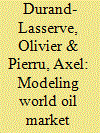| Srl | Item |
| 1 |
ID:
169721


|
|
|
|
|
| Summary/Abstract |
The use of uneconomic virtual transactions in day-ahead electricity markets with the intent to benefit related financial positions constitutes cross-product manipulation, and has emerged as a policy concern in recent years. Developing analytical frameworks and models to explain the means for achieving sustained day-ahead price manipulation is a challenge. This paper presents a two-stage equilibrium model of day-ahead price manipulation to enhance the value of financial transmission rights (FTRs). We cast the problem as a Stackelberg game between manipulating traders in the day-ahead market (leaders) and generating firms, grid operator and traders without FTRs in the day-ahead and real-time markets (followers). The model accounts for features specific to electricity systems, like intertemporal constraints of power generating units and real-time uncertainty, and considers imperfect competition as a condition allowing manipulation in equilibrium. We simulate hourly financial trading and operations decisions in a small test system for 24 hours. Results suggest that cross-product manipulation is sustained in equilibrium only when both physical and financial participants engage in Cournot competition. Further, as a result of loop flows, price separation between FTR source and sink may be induced by virtual transactions at network locations that are not on the FTR path.
|
|
|
|
|
|
|
|
|
|
|
|
|
|
|
|
| 2 |
ID:
181771


|
|
|
|
|
| Summary/Abstract |
The choice of a modeling approach is driven by the oil policy or market question that needs to be addressed. We provide the non-modeling community with insightful information on oil market models, shedding light on the economic interpretation of technical aspects (such as the meaning of the costs associated with certain types of constraints), but without introducing any mathematical formulations. We also emphasize the reasonings and assumptions underlying the modeling structures and solutions proposed in the literature. We first review how models have usually represented market fundamentals. We then examine recent modeling developments addressing market issues (such as the impact of the shale oil revolution and the shift in producers’ behavior) and policy questions (such as the use of spare capacity to stabilize prices, the lifting of export controls, and the management of uncertainties surrounding the energy transition) that have emerged since the Great Recession. Moreover, given that climate policies increase the interdependency of all energy markets, we discuss how long-term multi-fuel models produce scenarios for oil as part of the global energy mix. We also suggest ways to tackle questions not yet covered by the oil market modeling literature, such as the dependence of government budgets on oil revenues.
|
|
|
|
|
|
|
|
|
|
|
|
|
|
|
|